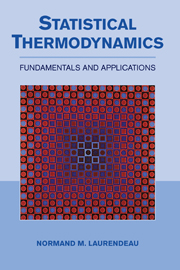Book contents
- Frontmatter
- Contents
- Preface
- 1 Introduction
- PART ONE FUNDAMENTALS OF STATISTICAL THERMODYNAMICS
- PART TWO QUANTUM MECHANICS AND SPECTROSCOPY
- PART THREE STATISTICAL THERMODYNAMICS IN THE DILUTE LIMIT
- PART FOUR STATISTICAL THERMODYNAMICS BEYOND THE DILUTE LIMIT
- 12 Thermodynamics and Information
- 13 Elements of the Solid State
- 14 Equilibrium Radiation
- Problem Set VI The Solid State and Radiation (Chapters 13–14)
- PART FIVE NONEQUILIBRIUM STATISTICAL THERMODYNAMICS
- PART SIX THE ENSEMBLE METHOD OF STATISTICAL THERMODYNAMICS
- PART SEVEN APPENDICES
- Index
13 - Elements of the Solid State
Published online by Cambridge University Press: 05 June 2012
- Frontmatter
- Contents
- Preface
- 1 Introduction
- PART ONE FUNDAMENTALS OF STATISTICAL THERMODYNAMICS
- PART TWO QUANTUM MECHANICS AND SPECTROSCOPY
- PART THREE STATISTICAL THERMODYNAMICS IN THE DILUTE LIMIT
- PART FOUR STATISTICAL THERMODYNAMICS BEYOND THE DILUTE LIMIT
- 12 Thermodynamics and Information
- 13 Elements of the Solid State
- 14 Equilibrium Radiation
- Problem Set VI The Solid State and Radiation (Chapters 13–14)
- PART FIVE NONEQUILIBRIUM STATISTICAL THERMODYNAMICS
- PART SIX THE ENSEMBLE METHOD OF STATISTICAL THERMODYNAMICS
- PART SEVEN APPENDICES
- Index
Summary
Our applications of statistical thermodynamics have thus far been mainly concerned with the gaseous state. We now move on to the solid state, with a particular focus in this chapter on metallic crystals, such as copper and silver. While semiconductors are, of course, very significant in an electronic age, their study is beyond the purview of this book, although our introduction to the solid state will surely pave the path for any future work that you might contemplate in this lucrative field.
In general, metallic crystals display a lattice structure, which features lattice sites occupied by metallic ions, but with their accompanying electrons migrating throughout the crystal. Because these ions are immobilized within a crystalline structure, they can vibrate about their equilibrium positions but they clearly cannot rotate or translate. Contrastingly, the electrons can surely translate, as indicated by their movement through any electrically conducting solid. In fact, as for individual metallic ions, electrons can be taken as independent particles because the electrostatic forces created between electrons and ions or among the electrons themselves are so long range that the electrons essentially move within a constant potential throughout the lattice structure. On the other hand, the mass of the electron is so tiny that our criterion for the dilute limit cannot possibly hold in this case, as verified by Eq. (9.5). Therefore, for the electron gas, we have no recourse but to summon basic Fermi–Dirac statistics.
- Type
- Chapter
- Information
- Statistical ThermodynamicsFundamentals and Applications, pp. 259 - 274Publisher: Cambridge University PressPrint publication year: 2005



